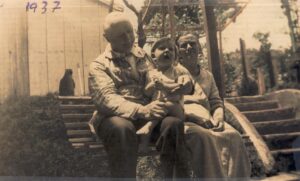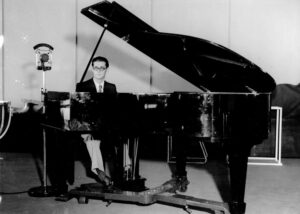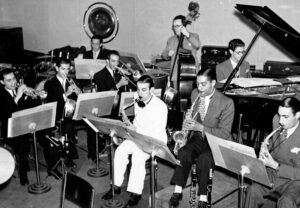- On July 18, in Rio de Janeiro (RJ), Alexandre Gnattali [1], the firstborn of the couple Radamés and Vera, was born.
 Alexandre, with his paternal grandparents, Alexandre and Adélia, and Bulungo, Aunt Aída’s parrot. Porto Alegre, 1937.
Alexandre, with his paternal grandparents, Alexandre and Adélia, and Bulungo, Aunt Aída’s parrot. Porto Alegre, 1937.
- Radamés turns 30 years old.
- On September 12, PRE-8, SociedadeRádioNacional do Rio de Janeiro, is inaugurated. Radamés is hired initially as an orchestra pianist and soon becomes an arranger and conductor.

Foto: Arquivo MIS
- 1936. Radamés on the piano at the PRE-8 Sociedade Rádio Nacional, in front of the microphone of the radio station, an icon of the Golden Era of Brazilian radio.

The All Star Orchestra, one of the Rádio Nacional orchestras in 1936, was formed by 2 trumpets, trombone, 2 alto saxophones (or 2 clarinets), tenor saxophone, piano, double bass, and drums. Radamés was the orchestra’s pianist and Simon Boutman conducted the orchestra. In the background, on drums, Luciano Perrone. One can see that the orchestra had a considerable percussion set, with timpani, gong, vibraphone, and drums.
- Radamés is responsible for the arrangements and musical direction of the revue in two acts and 40 paintings, Parada das Maravilhas [2], staged at the Theatro Municipal in Rio de Janeiro on October 10 and 18. Read more at Music on Stage > theater/dance.
- The Victor label releases Radamés’ choro
Amoroso
and waltzes
Two in the Morning
,
Springtime of Love
,
Zeli
e
Remembering the past
.
all tracks with the Victor Typical Orchestra.
Radamés composes:
-
- Concerto No. 2 for piano and orchestra
- Legend and Choro for string quartet
Rhapsody for two pianos and jazz
(incomplete) [3]
Waltz, Modinha and Jongo
[4] (Approximate year of composition. Unlocated work, quoted in newspapers of the time, sometimes as Suíte, sometimes as Miniaturas . In 1940 Radamés transcribed this piece for large orchestra with the title
Three Miniatures – Waltz, Modinha and Jongo
).
- Born in Rio de Janeiro, pianist and composer Luizinho Eça (Luiz Mainzi da Cunha Eça), to whom Radamés dedicates, in the 1960s, the Concerto Carioca nº 2 , for piano trio, bass and drums with a large orchestra.
- Oscar Niemeyer and Lúcio Costa design the headquarters of the Ministry of Education and Health, in Rio de Janeiro. The inspiration came from the Swiss architect Le Corbusier, with straight lines and a new concept of functionality.
- Santos Dumont Airport opens in Rio de Janeiro.
- The first recording of a concert on magnetic tape is made in Germany.
